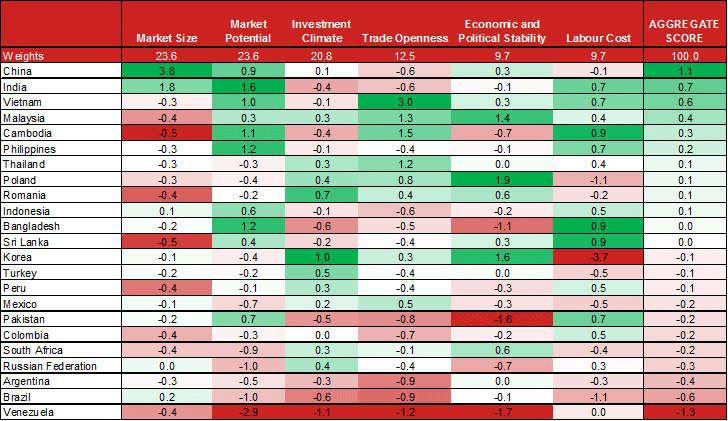
Are striving tiger cubs the next phase of flying geese?
In this report, our Asia economists present their scorecard of 23 Emerging Markets on foreign direct investment (FDI) attractiveness and confirm India and ASEAN’s advantage over other Emerging Markets due to multiple push and pull factors.
We estimate combined FDI flows into Asia’s tiger cubs – India and the ASEAN-5 (Indonesia, Malaysia, the Philippines, Thailand and Vietnam) – will surge from ~USD100bn per year now to around USD240bn by 2025. See key points from the report below:
The next big FDI opportunities
India and the ASEAN-5: Rising labor costs in China and an ageing population in Northeast Asia have disincentivized foreign direct investment (FDI), which must now find its next major destination. In this report, we make the case that Asia’s striving tiger cubs – India and the ASEAN-5 (Indonesia, Malaysia, Thailand, the Philippines and Vietnam) – are well placed to emerge as that destination. We believe this shift represents the next phase of the flying geese pattern of development.
More FDI inflow likely from Japan and China
Unlike in the past, when the US and EU accounted for bulk of the FDI flows into the cubs, we expect a growing regional bias as the source of FDI changes from the west to the east, and especially from high-saving Japan and China. For China, this is being triggered by an ongoing domestic slowdown, the government’s push for its Belt and Road Initiative and regional geopolitics. For Japan, the push to invest in emerging Asia reflects the need for new growth opportunities amid a contracting domestic market.
Pull factors in place for India and the ASEAN-5 to attract more FDI inflows
There are five pull factors that will encourage FDI into India and the ASEAN-5: 1) large and growing domestic markets; 2) reforms focused on improving infrastructure and the ease of doing business; 3) a more open and liberal FDI regime; 4) sound economic management and political stability; and 5) the availability of low-cost labor.
Nomura’s scorecard shows that Asia is more attractive to FDI than other EMs
We constructed an FDI attractiveness scorecard, in which we rank 23 EM economies by aggregating six variables that typically attract FDI: market size, market potential, investment climate, trade openness, economic and political stability and labor costs. The results show that Asian countries stand out and generally outperform other emerging markets, with China taking the top spot, followed by India and the ASEAN-5.
Nomura’s scorecard of FDI attractiveness

FDI flows could more than double from USD100bn currently to USD240bn by 2025:
We quantify the potential FDI inflows that India and the ASEAN-5 could attract over the next decade using two approaches: 1) a take-off comparison, where we use a period of rising FDI inflows into North Asia as a benchmark; and 2) a cross-country panel regression forecasting potential FDI inflows based on the various macro pull factors. An average of the two approaches shows that the projected gross FDI flows into India and ASEAN-5 combined will surge from the current ~USD100bn per annum to around USD240bn by 2025, with gross FDI inflows into ASEAN-5 doubling to USD113bn and those to India nearly tripling to USD126bn.
FX market implications: India and ASEAN to outperform
Solid net FDI inflows should support basic balance positions and local FX in the medium term. We continue to recommend long INR and THB (versus USD and SGD) and see medium-term positive total returns for long PHP, IDR and MYR positions.
Equity market implications
Changing FDI patterns will result in plenty of winners and some losers in both source (Japan, China) and destination (India, ASEAN) countries. Our preferred equity exposure to this theme is expressed in Nomura’s FDI equity basket.
Euben shares his views in an op-ed on Asia’s next FDI magnets with the Jakarta Post and for further insights, see the full report here.
Contributor

Sonal Varma
Chief Economist, India and Asia ex-Japan

Euben Paracuelles
Week Ahead Podcast Host and Chief ASEAN Economist

Saion Mukherjee
Head of Equity Research, India

Craig Chan
Global Head of FX Strategy
Disclaimer
This content has been prepared by Nomura solely for information purposes, and is not an offer to buy or sell or provide (as the case may be) or a solicitation of an offer to buy or sell or enter into any agreement with respect to any security, product, service (including but not limited to investment advisory services) or investment. The opinions expressed in the content do not constitute investment advice and independent advice should be sought where appropriate.The content contains general information only and does not take into account the individual objectives, financial situation or needs of a person. All information, opinions and estimates expressed in the content are current as of the date of publication, are subject to change without notice, and may become outdated over time. To the extent that any materials or investment services on or referred to in the content are construed to be regulated activities under the local laws of any jurisdiction and are made available to persons resident in such jurisdiction, they shall only be made available through appropriately licenced Nomura entities in that jurisdiction or otherwise through Nomura entities that are exempt from applicable licensing and regulatory requirements in that jurisdiction. For more information please go to https://www.nomuraholdings.com/policy/terms.html.


